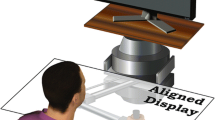Abstract
In order to control visually-guided voluntary movements, the central nervous system (CNS) must solve the following three computational problems at different levels: (1) determination of a desired trajectory in the visual coordinates, (2) transformation of the coordinates of the desired trajectory to the body coordinates and (3) generation of motor command. In this paper, the second and the third problems are treated at computational, representational and hardware levels of Marr. We first study the problems at the computational level, and then propose an iterative learning scheme as a possible algorithm. This is a trial and error type learning such as repetitive training of golf swing. The amount of motor command needed to coordinate activities of many muscles is not determined at once, but in a step-wise, trial and error fashion in the course of a set of repetitions. Actually, the motor command in the (n+1)-th iteration is a sum of the motor command in then-th iteration plus two modification terms which are, respectively, proportional to acceleration and speed errors between the desired trajectory and the realized trajectory in then-th iteration. We mathematically formulate this iterative learning control as a Newton-like method in functional spaces and prove its convergence under appropriate mathematical conditions with use of dynamical system theory and functional analysis. Computer simulations of this iterative learning control of a robotic manipulator in the body or visual coordinates are shown. Finally, we propose that areas 2, 5, and 7 of the sensory association cortex are possible sites of this learning control. Further we propose neural network model which acquires transformation matrices from acceleration or velocity to motor command, which are used in these schemes.
Similar content being viewed by others
References
Amari S (1977) Neural theory of association and concept formation. Biol Cybern 26:175–185
Arimoto S (1984) Theory of servomechanism and control of robots. J Robot Soc Jpn 2:480–486 (in Japanese)
Arimoto S, Miyazaki F (1984) Stability and robustness of PID feedback control for robot manipulators of sensory capability. Proc. ISRR, pp 783–799
Dennis Jr JE (1968) On Newton-like methods. Numer Math 11:324–330
Flash T, Hogan N (1985) The coordination of arm movements: an experimentally confirmed mathematical model. J Neurosci 5:1688–1703
Fukushima K (1973) A model of associative memory in the brain. Kybernetik 12:58–63
Grossberg S, Kuperstein M (1986) Neural dynamics of adaptive sensory-motor control: ballistic eye movements. North-Holland, Amsterdam
Hanafusa H, Yoshikawa T, Nakamura Y (1983) Redundancy analysis of articulated robot arms and its utilization for tasks with priority. Trans soc Instrum Control Eng 19:421–426 (in Japanese)
Hirsch MW, Smale S (1974) Differential equations, dynamical systems, and linear algebra. Academic Press, New York
Hollerbach JM (1982) Computers, brains and the control of movement. Trends Neurosci 5:189–192
Isobe M, Kawato M, Suzuki S (1987) Learning control of arm in binocular-retinal coordinates by iteration. Japan IEICE Technical Report MBE86-80:17–24 (in Japanese)
Kawato M (1988) Adaptation and learning in control of voluntary movement by the central nervous system. Adv Robot (in press)
Kawato M, Etoh M, Oda Y, Tsukahara N (1985) A new algorithm for voltage clamp by iteration: a learning control of a nonlinear neuronal system. Biol Cybern 53:57–66
Kawato M, Miyamoto H, Isobe M, Suzuki R (1986) Learning control of hand in task-oriented coordinate by iteration — a Newton-like algorithm-. Japan IECE Technical Report MBE85-91:83–92 (in Japanese)
Kawato M, Furukawa K, Suzuki R (1987a) A hierarchical neural-network model for control and learning of voluntary movement. Biol Cybern 57:169–185
Kawato M, Uno, Y, Isobe M, Suzuki R (1987b) A hierarchical model for voluntary movement and its application to robotics. Proceedings of the IEEE The First Annual International Conference on Neural Networks, San Diego, USA. June 21–24, 1987, IV, pp 573–582
Kawato M, Isobe M, Suzuki R (1988) Hierarchical learning of voluntary movement by cerebellum and sensory association cortex. In: Arbib MA, Amari S (eds) Competition and cooperation in neural nets. II. Lecture Notes in Biomathematics. Springer, Berlin Heidelberg New York: (to be published)
Marr D (1982) Vision. Freeman, New York
Mountcastel VB, Lynch JC, Georgopoulos AP, Sakata H, Aguna C (1975) Posterior parietal association cortex of the monkey: command functions for operations within extrapersonal space. J Neurophysiol 38:871–908
Murakami F, Etoh M, Kawato M, Oda Y, Tsukahara N (1986) Synaptic currents at interpositorubral and corticorubral excitatory synapses measured by a new iterative single electrode voltage-clamp method. Neurosci Res 3:590–605
Nakamura Y, Hanafusa H (1984) Singularity low-sensitive motion resolution of articulated robot arms. Trans Soc Instrum Control Eng 20:453–459 (in Japanese)
Park MR, Leber W, Klee MR (1981) Single electrode voltage clamp by iteration. J Neurosci Methods 3:271–283
Psaltis D, Sideris A, Yamamura A (1987) Neural controllers. Proceedings of the IEEE The First Annual International Conference on Neural Networks, San Diego, USA. June 21–24, 1987, IV, pp 551–558
Uno Y, Kawato M, Suzuki R (1987) Formation of optimum trajectory in control of arm movement — minimum torque-change model-.Jpn IEICE Techn Rep MBE86-79:9–16 (in Japanese)
Author information
Authors and Affiliations
Rights and permissions
About this article
Cite this article
Kawato, M., Isobe, M., Maeda, Y. et al. Coordinates transformation and learning control for visually-guided voluntary movement with iteration: A Newton-like method in a function space. Biol. Cybern. 59, 161–177 (1988). https://doi.org/10.1007/BF00318008
Received:
Issue Date:
DOI: https://doi.org/10.1007/BF00318008




